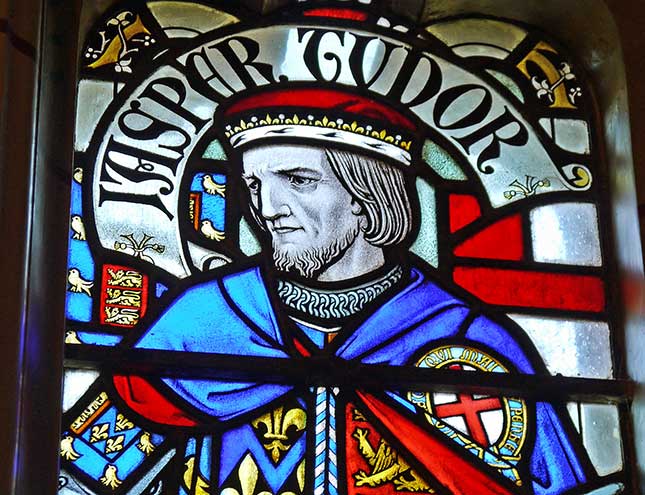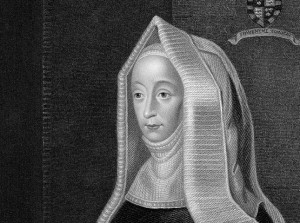With Tudor Times we profile a different figure every month. Here, Melita Thomas explores the unsung Tudor hero, Jasper Tudor.

Few people other than truly dedicated Tudor aficionados have ever heard of Jasper Tudor, or if they have, he is a mere foot note to his nephew, Henry VII. This is a pity, as Jasper lived a life of extraordinary adventure – even in a time when an astonishing proportion of his family and friends died in bloody circumstances.
Jasper was born in secret, the embarrassing evidence of a marriage that the establishment wanted hushed up. His mother was a dowager queen, Katherine de Valois, widow of the popular hero, Henry V, and his father, Owain Tudor, was an insignificant member of her household, who according to legend, gained her notice when he fell into her lap during a dance! Love matches were not appropriate for queens, and Katherine and Owain lived quietly away from court. Jasper was their second son, born around 1431.
Fortunately for Jasper and his older brother, Edmund, their half-brother, Henry VI, was a great deal more forgiving of his mother’s romantic marriage than his ministers had been. He brought the Tudor boys to court in the early 1440s and had them brought up honourably as his brothers.

In 1452, they were both knighted and received valuable earldoms as well as the joint wardship of King Henry’s wealthy cousin, Lady Margaret Beaufort, whom Edmund was to marry. Jasper’s earldom of Pembroke was centred in lands in south-west Wales, and during the 1450s he spent time there improving the fortifications at Pembroke Castle and at Tenby.
Henry VI, although a fond brother, and an affectionate husband to his French wife, Marguerite of Anjou, was not an effective king. During the late 1440s, his government was seen as incompetent, and heavily dominated by favourites, particularly Edmund Beaufort, Duke of Somerset.
The favour shown to Somerset rankled with Richard, Duke of York, who, until Queen Marguerite had her first child in 1453, had considered himself Henry’s heir. The clashes between the two dukes and their followers worsened and eventually descended into civil war – York and his relatives, the Earls of Salisbury and Warwick on one side, with Marguerite and Somerset leading the Lancastrians.
Jasper tried, initially, to steer a neutral course – co-operating with York where possible, but like most of Henry’s nobles, he drew the line at rebellion. Personal feelings were also involved – Edmund died after being held prisoner at Carmarthen Castle by York’s men. The loss of his elder brother left Jasper responsible not just for the widow, Margaret, but, from 1457 for her son, Henry Tudor, as well, and he took both duties very seriously.
In July 1460, Jasper achieved a previously unheard of military feat – he captured Denbigh Castle, one of Edward I’s almost impregnable fortresses in North Wales, which had been held by York. But the tide was flowing against Lancaster, and, despite the death of York at Wakefield in December 1460, York’s son, Edward, continued the war. Edward raced for Wales to prevent Marguerite from meeting up with the army that Jasper and his father were raising and annihilated the Lancastrians at Mortimer’s Cross, near Hereford.
Jasper was forced into hiding, while his father was summarily executed. Jasper spent the next few months flitting between the castles that were still under his control in Wales – Aberystwyth, Carreg Cennen, Denbigh and Harlech. In a final flourish, he raised another small force, together with the Duke of Exeter, but was defeated at Twt Hill, near Caernarfon.
After this skirmish, Jasper joined the other Lancastrian exiles in Scotland, but he was not content just to await events – he moved between the courts of France (Louis XI was his cousin), Brittany and Burgundy at different times, requesting support to re-establish Henry on the throne. The intrepid earl took part in raids and sieges in the north, and even made a couple of forays into Wales over the next few years, landing at Harlech, still valiantly holding out against the Yorkists. This culminated in a major attack on Denbigh in 1468, when Jasper and his men burnt the town. Pursued, he allegedly escaped dressed as a peasant, carrying a bundle of peas.
By 1469, the government of Edward IV was being challenged by his erstwhile supporter, the Earl of Warwick who joined forces with Marguerite and Jasper. The newly revitalised Lancastrians invaded England. Jasper was named as Joint Lieutenant of the Kingdom. After nearly a year of Lancastrian dominance, the Yorkists returned and Marguerite and her son were heavily defeated at Tewkesbury, with the young Lancastrian prince being killed.
During his period back home, Jasper had been reunited with his other nephew, the son of Edmund and Margaret Beaufort and Henry Tudor now became his focus. They escaped by sea, after hiding in a cellar in Tenby, and landed in Brittany.
Jasper bore 14 years of exile, a virtual prisoner, often separated from his nephew. But they never gave up hope. Political circumstances changed, and, in 1485, Henry and Jasper, set forth in borrowed ships to invade and reclaim the crown. Marching through Wales, Jasper’s old supporters swelled Henry’s army on its march to Bosworth. Following Henry’s victory there, Jasper received the reward that his years of loyalty deserved. He became Duke of Bedford, and was granted wide estates and a wealthy wife – Katherine Woodville, aunt of Henry’s new queen. Jasper continued to serve Henry at home and abroad until his death in 1495.







 © 2024
© 2024